- +91 9605 771 555, +91 7510 331 777
- jcetadmissions@nehrucolleges.com
jcetncerc@gmail.com
- Counselling Code : JCE
Computer Science and Engineering
About
Computer Science has become one of the most popular disciplines at the turn of the millennium. Perhaps the ever-increasing applications of computers in day-to-day life have raised interest as well as awareness. It is the modern, technological image of computing that continues to attract students to this branch. Undoubtedly job opportunities for graduates of Computer Science & Engineering are excellent. The Computer Science and Engineering can be compared to the brain in the human body. It is sophisticated and most powerful.
The Department guides and mold the students to become eminent engineers who have sound technical and management skills to excel in their profession. Students are given opportunities to develop their personality along with technical skills. It organizes supplementary programs, which include Paper Presentations, Technical seminars & Mock Interviews to prepare the students for a career in the computing field. This provides a wide range of opportunities for faculty and students to bring out their potential and innovative skills in a variety of fields.
HOD’S Desk
Computer Science is a relatively young discipline of research. Still, the first roots of computers — as machines that enhance our own thinking — go back more than a century. Alan Turing set the mathematical foundations of computing with the concept of Turing Machines. Turing was not only a brilliant theoretician, but also looked at very practical applications, such as for cryptanalysis (you might have watched the movie The Imitation Game); Turing is also considered a pioneer of Artificial Intelligence, an area that has gained much attention recently, not only within the research community, but also in the daily news. Think about self-driving cars, AI-driven medical diagnostics and personal health, face identification, or natural language understanding. John von Neumann was a brilliant mathematician, who developed the concepts of cellular automata, the universal constructor, and was a pioneer in digital computer architecture. We are still talking about the von Neumann architecture as the forefather of modern chips, which are now at the heart of our modern-time computers: think of smart phones, tablets, or smart watches. It should also be noted that many women have contributed to the discipline of computing and algorithmic machines such as Ada Lovelace, Grace Hopper, Frances E. Allan, and many, many more (see, for example, for more details: Women in computing - Wikipedia)
Therefore, even looking back at the origins of computers, Computer Science always had the aspiration to go way beyond “coding”. It has always been more than just writing programs to make machines perform algorithms. Computer Scientists are problem solvers. Computer Scientists create communities. We help to build the infrastructures for social networks; we also work on solutions to protect our personal data; make data communication secure across a wide variety of “communication networks”; we build solutions to visualize information; we work on tools that help to make decisions by asking smarter questions, and bring more and more data into our decision making.
With computers — as smart tools to help us think — we have to rely less on guessing. We can support our decisions by data. This is becoming more and more important in our increasingly digital economies. Hence, Data Science is a new area of research where we use computational tools to gather data, filter them, separate noise from useful information, and create knowledge — from which we can make better decisions and build smarter, enabling tools for our daily lives and to support our professional endeavours.
Join us, and become an ambassador of Computer Science. Learn more about Computer Science as a student; we love to share our passion with you. Learn how to not only use computational tools, but how to work in teams, share ideas, present, communicate — in short, join creative teams that make a positive difference.
Work with us if you are an entrepreneur or partner with us to enhance our digital economy, or let us help you solve challenges in your industry.
Following our Faculty of Science’s motto “Curiosity Drives Discovery”, we as Computer Scientists create computational “Discovery Tools” and “Think Tools”.
Welcome to our world.
| SI NO | NAME | DESIGNATION |
|---|---|---|
| Teaching Faculty | ||
| 01 | Dr.R. Satheesh Kumar | HoD & Professor |
| 02 | Dr Vijay Sankar | Professor |
| 03 | Mr. Manoj M | Assistant Professor |
| 04 | Mr.Ali Askar K M | Assistant Professor |
| 05 | Ms. Divya Visakh | Assistant Professor |
| 06 | Ms. Remya.M | Assistant Professor |
| 07 | Ms. Akhila.E | Assistant Professor |
| 08 | Ms. Shishira M.C | Assistant Professor |
| 09 | Ms Nisna Haneefa | Assistant Professor |
| 10 | Ms. Dhanyaja P | Assistant Professor |
| 11 | Mr. Ambarish A | Assistant Professor |
| 12 | Mr. Unnikrishnan S Kumar | Assistant Professor |
| 13 | Ms. Resmi C S | Assistant Professor |
| 14 | Ms.Nitha T M | Assistant Professor |
| 15 | Ms Jyotsna E | Assistant Professor |
| Technical Faculty | ||
| 01 | Mrs. Vinitha N | Lab Assistant |
| 02 | Mr. Madhusudhanan | Lab Assistant |
| 03 | Ms. Seetha S | Lab Assistant |
| 04 | Ms. Vidya P.S | Lab Assistant |
| 05 | Mr Sunil Chirakkal | Lab Assistant |
| 06 | Ms. Anusha K | Lab Assistant |
| 07 | Pratheesh P | System Admin |
Facilities
ADS Lab
- Number Of Systems:48
- Operating System : Windows 10 & Ubuntu 18.04
- Lab In Charge : Sunil C
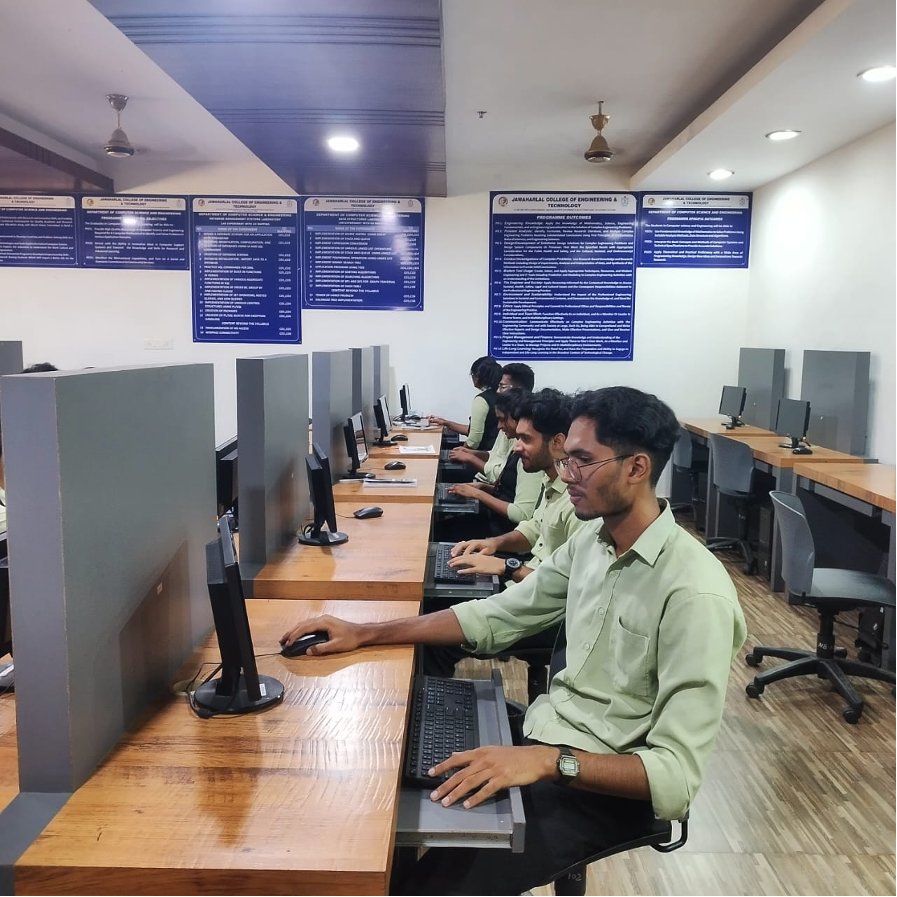
Systems Lab
- Number Of Systems : 48
- Operating System : Ubuntu & windows 10
- Lab In Charge : Vinitha N

Network Lab
- Number Of Systems : 60
- Operating System : Windows 10, ubuntu
-
Audio System : SLX 1008 Passive 2 way, 8", bass-reflex.
Cisco SpeakerTrack 60
Cisco Ceiling Microphone
Sonodyne Sonus 3260 Bookshelf Speakers - Lab In Charge : Madhusoodanan P V

Language Lab
- Number Of Systems : 24
- Operating System : Windows 7, Ubuntu 13.0
- Lab In Charge : Seetha
CADD Lab
- Number Of Systems : 64
- Operating System : Windows 7, Linux Mint
- Lab In Charge : Anjali
Programming Lab
- Number Of Systems : 64
- Operating System : windows 10, Ubuntu
- Lab In Charge : Vidhya P S
Internet Lab
- Number Of Systems : 44
- Operating System : Windows 7, Windows 8
- Lab In Charge : Aneesh
Achievements

Aryanadh TS got Placed in Indian Navy as Sub-Lieutenant IT Officer

Mr Mohammed Hussain A, S8 CSE secured first position in the Linguistic Excellence Competition organized by the Verb Vibe, the English Club of JCET on 24 April 2024.

Third year Computer Science and Engineering students won First position with a cash prize of Rs.6000/- in the project expo JSITE-2024 organized by JCET for their project titled “Go Green EV Charging Station Finder” The team members are Abhinav D, Abhishek P, Adwaith A Pillai, Ajmal Shan A, project guided by Mr. Unnikrishnan S Kumar, Assistant professor CSE.

Third year Computer Science and Engineering students won second position under department mini project category in the project expo JSITE-2024 organized by JCET for their project titled “Fake Product Detection Using Blockchain” The team members are Mohammed Aflah P T, Mohammed Fahad, Sanoj K B, Vyshak S.

Third year Computer Science and Engineering students won first position under department mini project category in the project expo JSITE-2024 organized by JCET for their project titled “Go Green EV Charging Station Finder” The team members are Abhinav D, Abhishek P, Adwaith A Pillai, Ajmal Shan A, project guided by Mr. Unnikrishnan S Kumar, Assistant professor CSE.

Final year Computer Science and Engineering students won first position under department main project category in the project expo JSITE-2024 organized by JCET for their project titled “Augmented White Board Using Computer Vision” The team members are Athul Nath M, Emmanuel Eldho, Muhammed Shehin Salim, Rahul N A.

Final year Computer Science and Engineering students won second position under department main project category in the project expo JSITE-2024 organized by JCET for their project titled “Smart Bin” The team members are Bhavya B, Farshan Mohammed Rafeek, Rana V A, Nikkitha B.
Second year computer science student Vishnu R won price in innovative projects category, the project titled as “Human Rescue Tech”.





Certificate distribution of participation in NGI TBI IDEATHON 2024 conducted on 12.02.2024 to MADHANRAJ M,MIDHUN S NAIR, MOHAMED NIYAZ N (S8 CSE)

Mr. Harikrishnan A
Sixth Semester student pursuing a Bachelor of Technology in Computer Science and Engineering on passing the GATE exam in 2023 with an impressive score of 371.

The automatic timetable generation system was selected as the best project in New Gen IEDC Projects 2023-2024, a project done by computer science students.
FACULTY ACHEIVEMENTS
- REMYA M,participated in workshop on CURRICULUM FRAMEWORK DESIGN AND DEVELOPMENT FOR NGI AUTONOMOUS INSTITUTIONS conducted by NIET Coimbatore, January 2024.
- AMBARISH A, participated in workshop on CURRICULUM FRAMEWORK DESIGN AND DEVELOPMENT FOR NGI AUTONOMOUS INSTITUTIONS conducted by NIET Coimbatore, January 2024.
- DIVYA VISHAK participated in workshop on CURRICULUM FRAMEWORK DESIGN AND DEVELOPMENT FOR NGI AUTONOMOUS INSTITUTIONS conducted by NIET Coimbatore, January 2024.
- REMYA M participated district level evaluation of young innovators program 5.0 categories 1 by KDISC, 2023.
- AKHILA E participated district level evaluation of young innovators program 5.0 categories 1 by KDISC, 2023
- NISNA HANEEFA K has participated in the WORKSHOP in EFFECTIVE PATTENT DRAFT held at NGI TBI. 2023
- DHANYAJA P participated in the professional development program on resilient pedagogy conducted by JCET, 2023
- SHISHIRA M C has participated three days face to face FDP on inculcating universal human values in technical education organized by AICTE, 2023
- UNNIKRISHNAN S KUMAR participated ICSSR sponsored national seminar on DEMOGRAPHIC DIVIDENT IN INDIA CHALLENGES AND OPPURTUNITIES held at JCET, 2023
- UNNIKRISHNAN S KUMAR participated ICSSR sponsored national seminar on DEMOGRAPHIC DIVIDENT IN INDIA CHALLENGES AND OPPURTUNITIES held at JCET, 2023
- REMYA M attended DELNET IIT DELHI webinar BEST PRACTICES FOR IMPROVING NIRF RANKING. 2022
- MANOJ M Published International Journal: Published a paper entitled State of the Art Techniques for Water Quality Monitoring Systems for Fish Ponds using loT and Underwater Sensors: A Review in the International Journal Sensors 2022, MDPI. (Volume 22, Special Issue 06, March 2022) ISSN: 1424-8220.
- Aiswarya R Of S6 CSE got selected as TATA consultancy services brand ambassador for 2021 passing out batch
- Secured second place for Calicut university s8 examination during 2018
- KSCSTE has recommended 10000 rupees to the project team of cse with members anusha, anushma, athira and nimisha
- Umesh m,Muhammad ashique, sabu siyad of s6 cse conduct a seminar on web development as a part of coders club activities on 29-08-2019
- Arjun T of S2 cse got selected for representing IEEE SB JCET TECHSORTIUM 2020
- Haritha p got 9.37 cgpa during first semester examination
- Aparna k p got 9.28 cgpa during first semester examination and 9.1 cgpa during second semester examination
- Anjana Vijayendran got 9.02 cgpa during first semester examination
- A R Anantha Krishnan got 9.11 cgpa during first semester examination
- Priyanka got 9.09 cgpa during first semester examination and 9.1 cgpa during second semester examination
- Anagha Aravind got 9.33 cgpa during first semester examination and 9.17 cgpa during second semester examination
- Lekha Raveendran got 9.43 cgpa during first semester examination
Staff Acheivements (Papers Published)
Mr. SARATH V SANKARAN
- 2017 - Pulished a paper on ”Combined mechanical biological treatment as a green C15 technology for energy recovery from municipal solid waste” in International Journal of Green Energy (Scopus Indexed).
Dr.RESHMI.B
- 2018- Pulished a paper on “An Improved Task Scheduling Strategy for High Performance in Cloud Computing Environment: Enhanced Design of a Workflow Approach”.
- 2018- Pulished a paper on “Profit and resource availability constrained optimal handling of Highperformance scientific computing Tasks”.
- 2020- Pulished a paper on “Data Gathering framework for coorelated data in wireless sensor networks”.
Ms. Greeshma G S
- 2017- Pulished a paper on “Removing blurness in PiCode using enhanced modulation”.
Ms.RESHMA V.K
- 2020 - Pulished a paper on "Pixel Prediction-Based Image Steganography by Support Vector Neural Network" in The Computer Journal : Oxford University Press (Science Citation Index).
- 2020 - Pulished a paper on "Optimized support vector neural network and contourlet transform for image steganography" in Evolutionary Intelligence Springer Link (Scopus Indexed).
- 2020 - Pulished a paper on "Chicken-Moth Search Optimization-Based Deep Convolutional Neural Network for Image Steganography" in Scalable Computing: Practice and Experience, (Scopus Indexed).
- 2020 - Pulished a paper on “Optimized and Dynamic Selection of Cluster Head Using Energy Efficient Routing Protocol in WSN.” In Wireless Pers Commun (2020) Springer Link(Science Citation Index).
- 2018 - Pulished a paper on Forensic Technique for Social Network Provenance Classification of Images in International Journal for Research in Applied Science & Engineering Technology (IJRASET).
- 2018 - Pulished a paper on Classification of Melanoma on Dermoscopy Images using SVM Classifier in International Journal for Research in Applied Science & Engineering Technology (IJRASET).
- 2018 - Pulished a paper on” Drowsy Driving Detection via Hybrid Deep Learning” in International Research Journal of Engineering and Technology (IRJET).
- 2020 - Pulished a paper on “EEG Emotion Recognition via Deep Convolutional Neural Network” in International conferences on Advances and Developments in Electrical and Electronics Engineering (ICADEE 2K20).
- 2020 - Pulished a paper on “EEG Emotion Recognition and Detection using Deep Convolutional Neural Network “ in International Conference on "Electrical Sciences" ICES-2020.
Mr.SHYJITH M.B
- 2020 - Pulished a paper on "Optimized support vector neural network and contourlet transform for image steganography" in Evolutionary Intelligence Springer Link (Scopus Indexed).
- 2020 - Pulished a paper on Optimized and Dynamic Selection of Cluster Head Using Energy Efficient Routing Protocol in WSN.in Wireless Pers Commun (2020) Springer Link (Science Citation Index).
- 2020 - Pulished a paper on "Chicken-Moth Search Optimization-Based Deep Convolutional Neural Network for Image Steganography" in Scalable Computing: Practice and Experience, (Scopus Indexed).
- 2020 - Pulished a paper on Data Gathering framework for coorelated data in wireless sensor networks in International Conference on Green, Intelligent Computing and Communication Systems 2020.
- 2020 - Pulished a paper on HMAC Balanced Load Sub Cluster head Selection for Wireless Sensor Networks in International research Journal of Engineering and Technology.
Ms.RAMYA T V
- 2020 - Pulished a paper on “Unsubstantiated Anthropological motion exploration for smart mobile robots” in International Journal for scientific research and development.
- 2020 - Pulished a paper on “ EARLY DETECTION OF LUNG CANCER USING DEEP LEARNING” in International Journal for scientific research and development.
Mr.MANOJ M
- 2018 - Pulished a paper on “Spammer Community used for Spam Detection in online social media reviews “ in International Journal for Research in Applied Science & Engineering Technology.
- 2020 - Pulished a paper on “Unsubstantiated Anthropological motion exploration for smart mobile robots” in International Journal for scientific research and development.
- 2020 - Pulished a paper on “EARLY DETECTION OF LUNG CANCER USING DEEP LEARNING” in International Journal for scientific research and development.
Ms.ANU T P
- 2018 - Pulished a paper on “Web Revisitation and Personalized Content Retrieval usingModular Ontology“ in International Journal for Research in Applied Science and Engineering Technology.
Ms.SREEKALA R
- 2020 - Pulished a paper on “MILITARY GRID REFERENCE SYSTEM USING VISUAL CRYPTOGRAPHY” in International Journal for Engineering and Technology.
Student Association (Xmeron )
Department of cse has student association named xmeron which is established on 2012. As a part of this association, we conducted certain workshops, seminars and other activities to promote students activities and develop knowledge.
One Day Workshop on JAVA(19/10/2015)
On October 19 2015, as part of XMERON, an Association initiative of CSE Department have conducted a workshop on JAVA for all semesters. The workshop was handled by eminent speakers Anil Kumar and Kripa Krishnan from THiNK Force Software Solution, Ernakulam. The event was hosted at Computer Lab in New Block Fourth floor from 9.00 AM to 4.00 PM



Inaugural function of “XMERON” held during January 19, 2016
Inaugural function of “XMERON”, the Computer Science and Engineering Association for the academic year 2015-2016 was held on 19th January 2016, Tuesday, at 10 am in Seminar Hall of New Block, Jawaharlal College of Engineering and Technology, Lakkidi


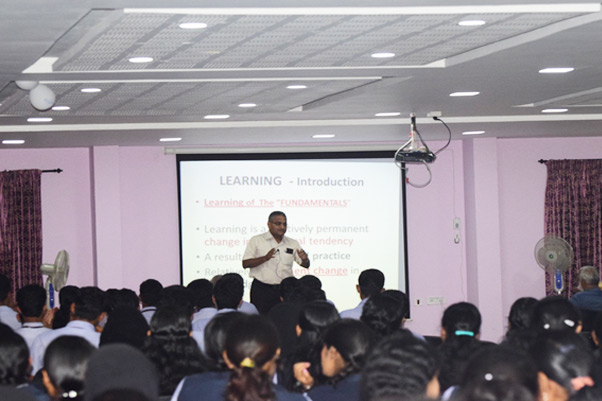
Special lecture on ‘Skills Development in Engineer Career’ held during January 19, 2016

A seminar on ‘Cyber Crimes and Security’ by Mr. Santhosh P K, Assistant Sub-Inspector of Police, Cyber Cell, Palakkad. held during January 19, 2016
Two Days Workshop on Android Development
On February 17 and 18, 2016, as part of XMERON, ARK Technosolutions and Robokart in association with IIT Madras have conducted a workshop on Android Development for S8 and S6 semesters. The workshop was handled by Rahul Yadav. The event was hosted at Computer Lab in New Block Fourth floor from 9.00 AM to 4.00 PM in that two days.

Inauguration of Association(XMERON),Technical club(EPSILON) & Hardware Maintenance Lab inauguration on 5th oct 2016
On 5th oct 2016 as part of XMERON, Association & technical club inauguration by chief guest Mr.Srinivas R Udupa,Business Planning Manager, HP Enterprise Bangalore, Hardware Maintenance Lab inauguration by Dr.U Lazar John. Technical Talk on "Analytics and IT Application " by Mr.Srinivas R Udupa, Technical quiz conducted by JCET alumni Arun K Vinod
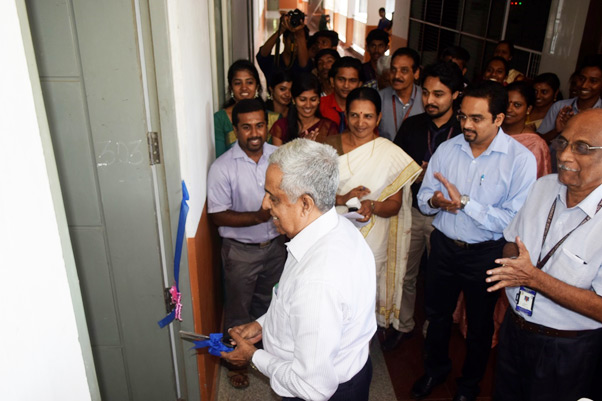
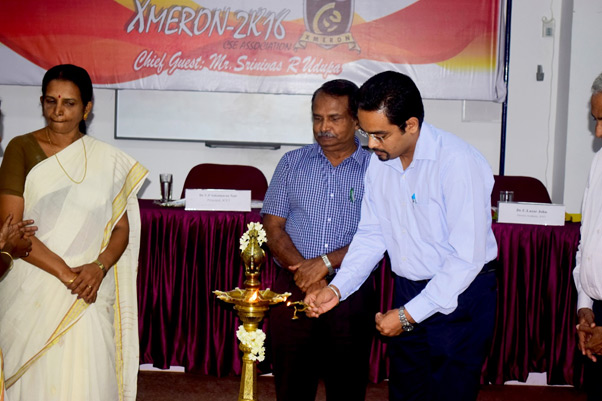






4 Days Workshop for S7 Students of jcet regarding “Mobile App Development using Apache Cordova” from 11 to 14 th july,2016 by Mr.A.Ramkumar,Android Trainer & developer, Madurai



2 day Workshop on "Graphic and Website Design Using Adobe Photoshop and Muse" by Mr.Vishak.V.K ,Graphic Designer and trainer, Coimbatore for S5 CSE Students conducted on 21 and 22 july ,2016
Four workshops on different topics in association with NGI opensource foundation
- 11/07/18-web development-conducted by Mr.jiss anto (2013-17 passout)
- 12/07/18 and 16/07/18 -introduction and familiariazation to arduino kit- conducted by Dr.felix M Philip
- 17/07/18 and 18/07/18 -programming logic using SCRATCH conducted by Mr.Scaria Alex
- 19/07/18 and 20/07/18- ethical hacking conducted by Mr.Nikhil N(2013-17 passout)
As a part of aarsh 2k18, department of cse conducted various events like data mineria,technozzare,beaten path, fluro league,kurukshetra and mirage on 17 th November ,2018


22/08/19- student association inauguration
Conducted xmeron student association inauguaration on 22-08-2019.As a part of inauguration conducted certain events like technical quiz,memory gaming,virtual reality show etc



Poster Making Contest
Coders club jcet organized a poster making contest with the theme independence day from 12-aug-2020 to 14-aug-2020.The event was conducted through online due to this pandemic condition of Covid-19

Webinar on “Wordpress”
Coders club jcet conducted a webinar on “Wordpress” which mainly focused for online learning.The event was organized for jcet students on 06-aug-2020.

Webinar on ”Quantitative data analysis in R using STATCRAFT”
Department of CSE in association with STATCRAFT organized a webinar on”Quantitative data analysis in R using STATCRAFT” on 18 th november 2020.Due to this pandemic condition,the event was conducted throgh online and the session was officially inauguarated by Dr.Reshmi B,HOD,Department of computer science and engineering.

Webinar on ”Digital investigation and Cyber forensics”
Department of CSE organized a webinar on”Digital investigation and cyber forensics” on 29 th may 2020.Due to this pandemic condition,the event was conducted throgh online and the session was officially inauguarated by Dr.Reshmi B,HOD,Department of computer science and engineering.

Webinar on ”Deep learning”
Department of CSE organized a webinar on”Deep learning” on 22 nd may 2020.Due to this pandemic condition,the event was conducted throgh online and the session was officially inauguarated by Dr.Reshmi B,HOD,Department of computer science and engineering.
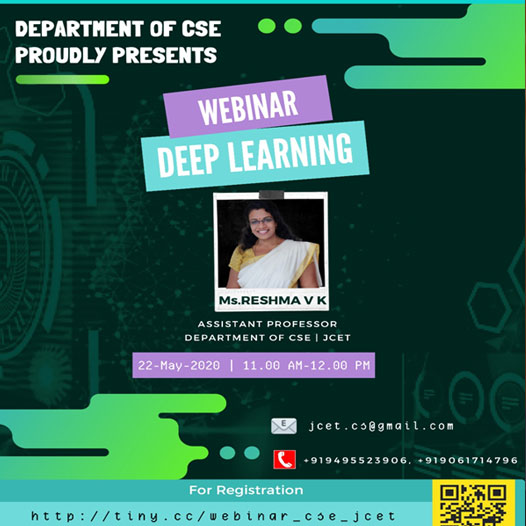
Coders Club
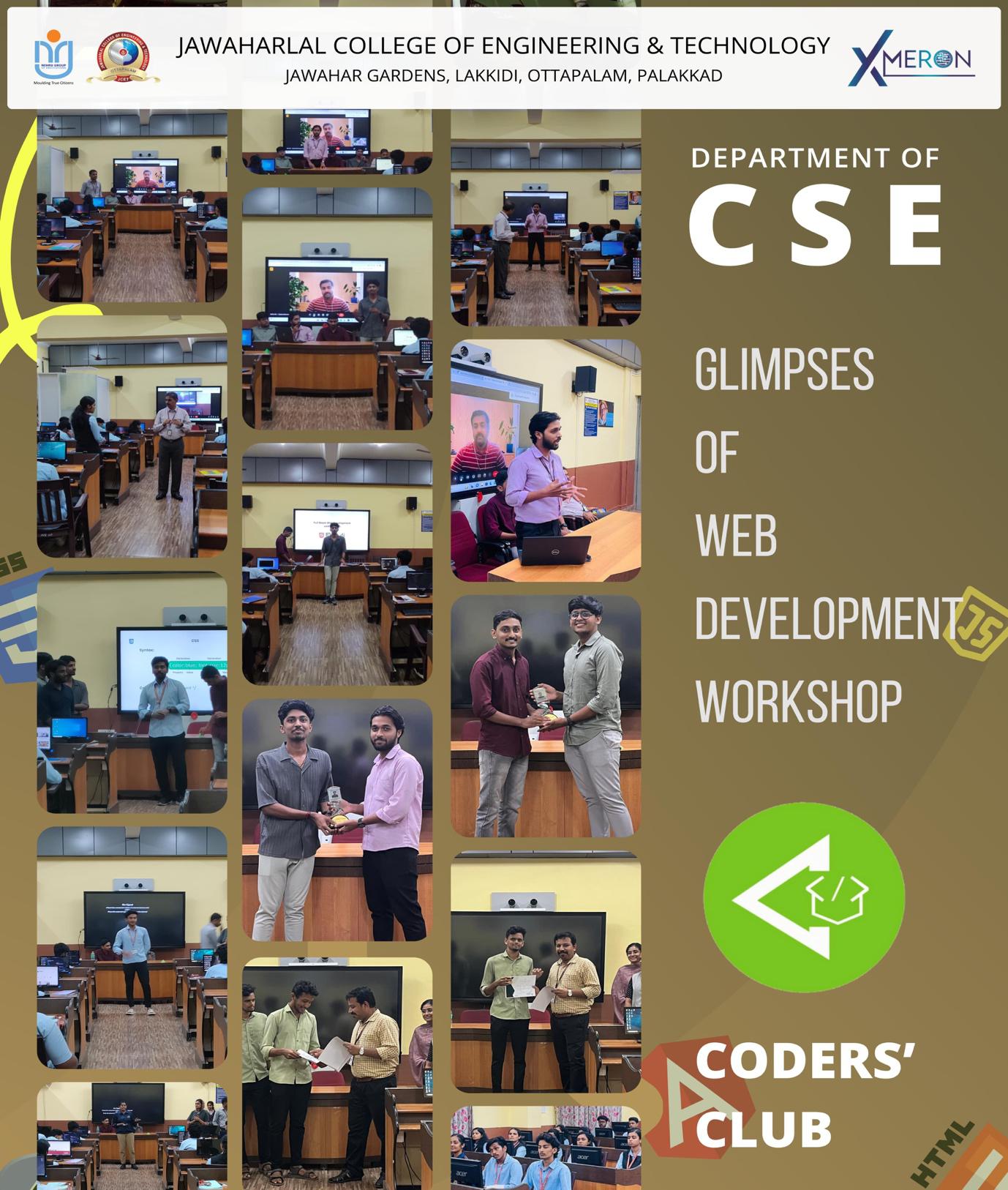
"At the inauguration of the 'Coders Club' powered by XMERON, a workshop on 'Web Development' was conducted for 2nd-year CSE students on November 4, 2023. Dr. N Gunasekaran, Principal JCET, facilitated an interactive session with students and introduced Mr. Mohammed Hussain, a final year B.Tech student placed in UST Global, who shared his placement experience. Dr. Scaria Alex, Associate Professor-CSE, inaugurated the program, with Dr. N Gunasekaran and other teaching faculty in attendance. Mr. Arjun T and Mr. Mohammed Afkar, alumni and freelance programmers, served as resource persons. The program was felicitated by Mr. Mohammed Hussain and Mr. Emmanuel Eldho, with a vote of thanks from Mr. Mohammed Midhlaj, Vice-President of the Coders Club."
LaTeX Using Overleaf

"The 'LaTeX Using Overleaf' workshop, led by Ms. Divya Vishak, at Jawaharlal College of Engineering and Technology's Network Lab on 02/11/2023, aimed to introduce participants to LaTeX and provide hands-on experience with Overleaf for collaborative writing. Ms. Vishak, an experienced LaTeX user, guided attendees through various exercises, including creating basic LaTeX documents and collaborative editing. The workshop received positive feedback, with participants praising Ms. Vishak's expertise and suggesting more advanced sessions to further explore LaTeX's capabilities."
Inauguration Ceremony


News & Events
Seminar on Recurrent Neural Network And Its Applications

Department of Computer Science and Engineering present seminar on " Recurrent Neural Network And Its Applications " for S3 students .Presented by Sonu Varghese K , full time PhD Schola , Computer Science And engineering , SCET
Alumni Talk Section

Department of Computer Science and Engineering conduct an alumni talk section " Take an 'E' - Book " By Vyasan P M ; Project Manager at tECHZERA INFOLOGICS
Presentation on Plant Growth Prediction & Suggestion Tool

Ms Divya Visakh (Assistant Professor CSE) Insightful presentation on “ Plant Growth Prediction & Suggestion Tool" organized by Department of Agricultural Engineering
Guest lecture on Module Programming in C

On 5th April 2024, XMERON, The Student Association of Computer Science and Engineering(CSE), organized a guest lecture on "Module Programming in C." The lecture aimed to provide insights into the fundamentals and applications of module programming in the C language. Mr.Manoj M, an Assistant Professor in CSE, delivered the lecture.
SELF DEVELOPMENT FOR CAMPUS PLACEMENTS

Ms. Sreejitha, Software Engineer, TATA ELXSI, Alumni of JCET 2018-2022 CSE addressing S4 students on SELF DEVELOPMENT FOR CAMPUS PLACEMENTS.
Vision
To produce competent professionals with research and innovative skills, by providing them with the most conducive environment for quality academic and research oriented undergraduate education along with moral values committed to build a vibrant nation.
Mission
- Provide a learning environment to develop creativity and problem solving skills in a professional manner.
- Expose to latest technologies and tools used in the field of computer science.
- Provide a platform to explore the industries to understand the work culture and expectation of an organization.
- Enhance Industry Institute Interaction program to develop the entrepreneurship skills.
- Develop research interest among students which will impart a better life for the society and the nation.
Program Educational Objectives (PEOs)
Graduates will be able to
- Provide high-quality knowledge in computer science and engineering required for a computer professional to identify and solve problems in various application domains.
- Persist with the ability in innovative ideas in computer support systems and transmit the knowledge and skills for research and advanced learning.
- Manifest the motivational capabilities, and turn on a social and economic commitment to community services.
Program Specific Outcomes (PSOs)
The students will be able to
- Use fundamental knowledge of mathematics to solve problems using suitable analysis methods, data structure and algorithms.
- Interpret the basic concepts and methods of computer systems and technical specifications to provide accurate solutions.
- Apply theoretical and practical proficiency with a wide area of programming knowledge, design new ideas and innovations towards research.
SEMESTER 1
|
Subject Code |
Name of the Subject |
Text Books |
Reference Books |
|
MAT 101 |
Linear Algebra and Calculus |
1. H. Anton, I. Biven,S.Davis, “Calculus”, Wiley, 10th edition, 2015. 2. Erwin Kreyszig, Advanced Engineering Mathematics, 10thEdition, John Wiley & Sons, 2016 |
1. J. Stewart, Essential Calculus, Cengage, 2nd edition, 2017 2. G.B. Thomas and R.L. Finney, Calculus and Analytic geometry, 9th Edition, Pearson, Reprint, 2002. 3. Peter V. O'Neil, Advanced Engineering Mathematics , Cengage, 7th Edition, 2012 4. Veerarajan T., Engineering Mathematics for first year, Tata McGraw-Hill, New Delhi, 2008. 5. B.S. Grewal, Higher Engineering Mathematics, Khanna Publishers, 36 Edition, 2010. |
|
CYT 100 |
Engineering Chemistry |
1. B. L. Tembe, Kamaluddin, M. S. Krishnan, “Engineering Chemistry (NPTEL Web-book. 2.P. W. Atkins, “Physical Chemistry”, Oxford Univeristy Press,10th Edition |
1. C. N. Banwell, “Fundamentals of Molecular Spectroscopy”, McGraw-Hill, 4thedn., 1995. 2. Donald L. Pavia, “Introduction to Spectroscopy”, Cengage Learning India Pvt. Ltd., 2015. 3. B. R. Puri, L. R. Sharma, M. S. Pathania, “Principles of Physical Chemistry”, Vishal Publishing Co., 47th Edition, 2017. 4. H. H. Willard, L. L. Merritt, “Instrumental Methods of Analysis”, CBS Publishers, 7th Edition, 2005. |
|
EST 110 |
Engineering Graphics |
1. Bhatt, N.D., Engineering Drawing, Charotar Publishing House Pvt. Ltd 2. John, K.C. Engineering Graphics, Prentice Hall India Publishers. |
1. Anilkumar, K.N., Engineering Graphics, Adhyuth narayan 2.Agrawal, B. And Agrawal, C.M., Engineering Darwing, Tata McGraw Hill Publishers. 3. Benjamin, J., Engineering Graphics, Pentex Publishers- 3rd Edition, 2017. 4.Duff, J.M. and Ross, W.A., Engineering Design and Visualisation, Cengage Learning. 5. Kulkarni, D.M., Rastogi, A.P. and Sarkar, A.K., Engineering Graphics with AutoCAD, PHI 6. Luzaddff, W.J. and Duff, J.M., Fundamentals of Engineering Drawing, PHI. 7. Varghese, P.I., Engineering Graphics, V I P Publishers 8. Venugopal, K., Engineering Drawing and Graphics, New Age International Publishers. |
|
EST130 |
Basics of Electrical& Electronics Engineering |
1. D P Kothari and I J Nagrath, “Basic Electrical Engineering”, Tata McGraw Hill, 2010. 2.D C Kulshreshtha, “Basic Electrical Engineering”, Tata McGraw Hill, 2010. 3.ChinmoySaha, Arindham Halder and Debarati Ganguly, Basic Electronics - Principles and Applications, Cambridge University Press, 2018 4. M.S.Sukhija and T.K.Nagsarkar, Basic Electrical and Electronics Engineering, Oxford University Press, 2012. 5. Wayne Tomasi and Neil Storey, A Textbook On Basic Communication and Information Engineering, Pearson, 2010. |
1. Del Toro V, “Electrical Engineering Fundamentals”, Pearson Education. 2.T. K. Nagsarkar, M. S. Sukhija, “Basic Electrical Engineering”, Oxford Higher Education 3.Hayt W H, Kemmerly J E, and Durbin S M, “Engineering Circuit Analysis”, Tata McGraw-Hill 4.Hughes, “Electrical and Electronic Technology”, Pearson Education 5.V. N. Mittle and Arvind Mittal, “Basic Electrical Engineering,” Second Edition, McGraw Hill. 6. Parker and Smith, “Problems in Electrical Engineering”, CBS Publishers and Distributors. 8. Anant Agarwal, Jeffrey Lang, Foundations of Analog and Digital Electronic Circuits, Morgan 9.Bernard Grob, Ba sic Electronics, McGraw Hill. 10. A. Bruce Carlson, Paul B. Crilly, Communication Systems: An Introduction to Signals and |
|
HUN 101 |
Life Skiils |
|
1. Shiv Khera, You Can Win, Macmillan Books, New York, 2003. 2. Barun K. Mitra, “Personality Development & Soft Skills”, Oxford Publishers, Third impression, 2017. 3. ICT Academy of Kerala, "Life Skills for Engineers", McGraw Hill Education (India) Private Ltd., 2016. 4. Caruso, D. R. and Salovey P, “The Emotionally Intelligent Manager: How to Develop and Use the Four Key Emotional Skills of Leadership”, John Wiley & Sons, 2004. 5. Kalyana, “Soft Skill for Managers”; First Edition; Wiley Publishing Ltd, 2015. 6. Larry James, “The First Book of Life Skills”; First Edition, Embassy Books, 2016. 7. Shalini Verma, “Development of Life Skills and Professional Practice”; First Edition; Sultan Chand (G/L) & Company, 2014 8. Daniel Goleman, "Emotional Intelligence"; Bantam, 2006 9. Remesh S., Vishnu R.G., "Life Skills for Engineers", Ridhima Publications, First Edition, 2016 10. Butterfield Jeff, “Soft Skills for Everyone”, Cengage Learning India Pvt Ltd; 1 edition, 2011 11. Training in Interpersonal Skills: Tips for Managing People at Work, Pearson Education, India; 6 edition, 2015. 12. The Ace of Soft Skills: Attitude, Communication and Etiquette for Success, Pearson Education; 1 edition, 2013. |
SEMESTER 2
|
Subject Code |
Name of the Subject |
Text Books |
Reference Books |
|
MAT 102 |
Vector Calculus,Differential Equations and Transforms |
1. H. Anton, I. Biven S.Davis, “Calculus”, Wiley, 10th edition, 2015. 2. Erwin Kreyszig, “Advanced Engineering Mathematics”, Wiley, 10th edition, 2015. |
1. J. Stewart, Essential Calculus, Cengage, 2nd edition, 2017 2. G.B. Thomas and R.L. Finney, Calculus and Analytic geometry, 9 th Edition, Pearson,Reprint, 2002 3. Peter O Neil, Advanced Engineering Mathematics, 7th Edition, Thomson, 2007. 4. Louis C Barret, C Ray Wylie, “Advanced Engineering Mathematics”, Tata McGraw Hill, 6th edition, 2003. 5. VeerarajanT.”Engineering Mathematics for first year”, Tata McGraw - Hill, 2008. 6. B.S. Grewal, Higher Engineering Mathematics, Khanna Publishers, 36th edition , 2010. 7. Srimanta Pal, Subodh C. Bhunia, “Engineering Mathematics”, Oxford University Press, 2015. 8. Ronald N. Bracewell, “The Fourier Transform and its Applications”, McGraw – Hill International Editions, 2000. |
|
PHT 100 |
Engineering Physics A |
1. M.N.Avadhanulu, P.G.Kshirsagar,TVS Arun Murthy “A Text book of Engineering Physics”, S.Chand &Co., Revised Edition 2019 2. H.K.Malik , A.K. Singh, “Engineering Physics” McGraw Hill Education, Second Edition 2017 |
1. M.N.Avadhanulu, P.G.Kshirsagar,TVS Arun Murthy “A Text book of Engineering Physics”, S.Chand &Co., Revised Edition 2019 2. H.K.Malik , A.K. Singh, “Engineering Physics” McGraw Hill Education, Second Edition 2017 |
|
EST 100 |
Engineering Mechanics |
1. Timoshenko and Young, Engineering Mechanics, McGraw Hill Publishers. 2. Shames, I. H., Engineering Mechanics - Statics and Dynamics, Prentice Hall of India. 3. R. C. Hibbeler and Ashok Gupta, Engineering Mechanics, Vol. I statics, Vol II Dynamics, Pearson Education. |
1. Merriam J. L and Kraige L. G., Engineering Mechanics - Vols. 1 and 2, John Wiley. 2. Tayal A K, Engineering Mechanics – Statics and Dynamics, Umesh Publications. 3. Bhavikkatti, S.S., Engineering Mechanics, New Age International Publishers. 4. F.P.Beer abd E.R.Johnston (2011), Vector Mechanics for Engineers, Vol.I-Statics, Vol.II-Dynamics, 9 th Ed, Tata McGraw Hill. 5. Rajasekaran S and Sankarasubramanian G, Engineering Mechanics - Statics and Dynamics, Vikas Publishing House Pvt Ltd. |
|
EST 120 |
Basics of Civil & Mechanical Engineering |
1. Rangwala, S. C., Essentials of Civil Engineering, Charotar Publishing House 2. Mckay, W.B. and Mckay, J. K., Building Construction, Volumes 1 to 4, Pearson India Education Services |
1. Chen W.F and Liew J Y R (Eds), The Civil Engineering Handbook. II Edition CRC Press (Taylor and Francis. 2.Chudley, R and Greeno R, Building construction handbook, Addison Wesley, Longman group, England 3.Chudley, R, Construction Technology, Vol. I to IV, Longman group, England Course Plan 4. Kandya A A, Elements of Civil Engineering, Charotar Publishing house 5. Mamlouk, M. S., and Zaniewski, J. P., Materials for Civil and Construction Engineering, Pearson Publishers 6. Rangwala S.C and Dalal K B Building Construction Charotar Publishing house 7. Clifford, M., Simmons, K. and Shipway, P., An Introduction to Mechanical Engineering Part I - CRC Press 8. Roy and Choudhary, Elements of Mechanical Engineering, Media Promoters &Publishers Pvt. Ltd., Mumbai. 9. Sawhney, G. S., Fundamentals of Mechanical Engineering, PHI 10. G Shanmugam, M S Palanichamy, Basic Civil and Mechanical Engineering, McGraw Hill Education; First edition, 2018 11. Benjamin,J.,Basic Mechanical Engineering,Pentex Books,9th Edition,2018 12. Balachandran, P.Basic Mechanical Engineering,Owl Books |
|
HUN 102 |
Professional Communication |
|
1. English for Engineers and Technologists (Combined edition, Vol. 1 and 2), Orient Blackswan 2010. 2. Meenakshi Raman and Sangeetha Sharma,”Technical Communication: Principles and Practice”, 2nd Edition, Oxford University Press, 2011 3. Stephen E. Lucas, "The Art of Public Speaking", 10th Edition; McGraw Hill Education, 2012. 4. Ashraf Rizvi, "Effective Technical Communication", 2nd Edition, McGraw Hill Education, 2017 5. William Strunk Jr. & E.B. White, "The Elements of Style", 4th Edition, Pearson, 1999 6. David F. Beer and David McMurrey, Guide to writing as an Engineer, John Willey. New York, 2004 7. Goodheart-Willcox, "Professional Communication", First Edition , 2017 8. Training in Interpersonal Skills: Tips for Managing People at Work, Pearson Education, India, 6 edition, 2015. 9. The Ace of Soft Skills: Attitude, Communication and Etiquette for Success, Pearson Education; 1 edition, 2013. 10. Anand Ganguly, “Success in Interview”, RPH, 5th Edition, 2016. 11. Raman Sharma, “Technical Communications”, Oxford Publication, London, 2004. |
|
EST 102 |
Programming in C |
1. Schaum Series, Gottfried B.S.,Tata McGraw Hill,Programming with C 2. E. Balagurusamy, Mcgraw Hill,Programming in ANSI C 3. Asok N Kamthane, Pearson,Programming in C 4. Anita Goel, Pearson, Computer Fundamentals |
1. Anita Goel and Ajay Mittal, Pearson, Computer fundamentals and Programming in C 2. Brian W. Kernighan and Dennis M. Ritchie, Pearson, C Programming Language 3. Rajaraman V, PHI, Computer Basics and Programming in 4. Yashavant P, Kanetkar, BPB Publications, Let us C |
SEMESTER 3
|
Subject Code |
Name of the Subject |
Text Books |
Reference Books |
|
MAT 203 |
Discrete Computational Structures |
1. Discrete and Combinatorial Mathematics (An Applied Introduction), Ralph P Grimaldi, B V Ramana , 5th Edition, Pearson |
1) Kenneth H. Rosen, Discrete Mathematics and Its Applications with Combinatorics and |
|
CST 201 |
Data Structures |
1. Ellis Horowitz, Sartaj Sahni and Susan Anderson-Freed, Universities Press, |
1. Samanta D., Classic Data Structures, Prentice Hall India. |
|
CST 203 |
Logic System Design |
1. M. Morris Mano, Digital Logic & Computer Design, 4/e, Pearson Education, 2013 |
1. M. Morris Mano, Michael D Ciletti , Digital Design With An Introduction to the Verilog |
|
CST 205 |
Object Oriented Programming Using Java |
1. Herbert Schildt, Java: The Complete Reference, 8/e, Tata McGraw Hill, 2011. |
1. Y. Daniel Liang, Introduction to Java Programming, 7/e, Pearson, 2013. |
|
EST 200 |
Design and Engineering |
1) YousefHaik, SangarappillaiSivaloganathan, Tamer M. |
1.Philip Kosky, Robert Balmer, William Keat, George Wise, |
|
MNC 201 |
Sustainable Engineering |
Allen, D. T. and Shonnard, D. R., Sustainability Engineering: Concepts, Design and Case Studies, Prentice Hall. |
1. Bradley. A.S; Adebayo,A.O., Maria, P. Engineering applications in sustainable design and development, Cengage learning |
SEMESTER 4
|
Subject Code |
Name of the Subject |
Text Books |
Reference Books |
|
MAT 206 |
Graph Theory |
1. Narsingh Deo, Graph theory, PHI,1979 |
1. R. Diestel, Graph Theory, free online edition, 2016: diestel-graph-theory.com/basic.html. |
|
CST 202 |
Computer Organization &Architecture |
1. Hamacher C., Z. Vranesic and S. Zaky, Computer Organization ,5/e, McGraw Hill, 2011 |
1. Mano M. M., Digital Logic & Computer Design, 3/e, Pearson Education, 2013. |
|
CST204 |
Data Base Management System |
1. Elmasri R. and S. Navathe, Database Systems: Models, Languages, Design and Application Programming, Pearson Education, 2013. 2. Sliberschatz A., H. F. Korth and S. Sudarshan, Database System Concepts, 6/e, McGraw Hill, 2011. |
1. Adam Fowler, NoSQL for Dummies, John Wiley & Sons, 2015 2. NoSQL Data Models: Trends and Challenges (Computer Engineering: Databases and Big Data), Wiley, 2018 |
|
CST 206 |
Operating System |
1. Abraham Silberschatz, Peter Baer Galvin, Greg Gagne, ' Operating System Concepts' 9th Edition, Wiley India 2015. |
1. Andrew S Tanenbaum, “Modern Operating Systems” , 4th Edition, Prentice Hall, 2015. |
|
CST 282(Minor) |
Programming Methodologies |
1. Robert W. Sebesta, Concepts of Programming Languages, 10th Edition, Pearson. |
1. Kenneth C. Louden, Programming Languages: Principles and Practice, |
|
CST 284(Minor) |
Mathematics for Machine Learning |
1.Mathematics for Machine Learning by Marc Peter Deisenroth, A. Aldo Faisal, and |
1. Linear Algebra and Its Applications, 4th Edition by Gilbert Strang |
|
MCN 202 |
Constitution of India |
1. D D Basu, Introduction to the constitution of India, Lexis Nexis, New Delhi, 24e, 2019 |
1. Ministry of law and justice, The constitution of India, Govt of India, New Delhi, 2019. |
|
HUT 200 |
Professional Ethics |
1. M Govindarajan, S Natarajan and V S Senthil Kumar, Engineering Ethics, PHI Learning Private Ltd, New Delhi,2012. |
1. Mike W Martin and Roland Schinzinger, Ethics in Engineering,4th edition, Tata McGraw Hill Publishing Company Pvt Ltd, New Delhi,2014. |
|
CST292 |
Number Theory |
1. G.A. Jones & J.M. Jones, Elementary Number Theory, Springer UTM, 2007. |
1.William Stallings, Cryptography and Network Security Principles and Practice, Pearson Ed. |
SEMESTER 5
|
Subject Code |
Name of the Subject |
Text Books |
Reference Books |
|
CS301 |
Theory of Computation |
1. John E Hopcroft, Rajeev Motwani and Jeffrey D Ullman, Introduction to Automata Theory, Languages, and Computation, 3/e, Pearson Education, 2007 |
1. Dexter C. Kozen, Automata and Computability, Springer1999. |
|
CS303 |
System Software |
1. Leland L. Beck, System Software: An Introduction |
1. D.M. Dhamdhere, Systems Programming and Operating Systems, Second |
|
CS305 |
Microprocessor and Micro controllers |
1. Bhurchandi and Ray, Advanced Microprocessors and Peripherals, Third Edition McGraw Hill, 2012 |
1. Barry B. Brey, The Intel Microprocessors – Architecture, Programming and Interfacing, Eigth Edition, Pearson Education, 2015 2. A. NagoorKani, Microprocessors and Microcontrollers, Second Edition, Tata McGraw Hill, 2012. |
|
CS307 |
Data Communication |
1. William Stallings, Data and Computer Communication 9/e, Pearson Education, Inc. [Chapters: 4, 5, 6, 7, 8, 9]. |
1. Forouzan B. A., Data Communications and Networking, 4/e, Tata McGraw Hill, 2007. |
|
CS309 |
Graph theory & Combinatorics |
1. Douglas B. West, Introduction to Graph Theory, Prentice Hall India Ltd., 2001 |
1. R. Diestel, Graph Theory, free online edition, 2016: diestel-graph-theory.com/basic.html. |
|
CS361 |
Soft Computing |
1. S. N. Sivanandam and S. N.Deepa, Principles of soft computing – John Wiley & Sons, |
1.N. K. Sinha and M. M. Gupta, Soft Computing & Intelligent Systems: Theory & |
|
CS365 |
Optimization Techniques |
3. Robin J. Wilson, Introduction to Graph Theory, Longman Group Ltd., 2010 |
|
SEMESTER 6
|
Subject Code |
Name of the Subject |
Text Books |
Reference Books |
|
CS302 |
Design and Analysis of Algorithms |
1. Ellis Horowitz, SartajSahni, SanguthevarRajasekaran, Computer Algorithms, Universities Press, 2007 [Modules 3,4,5] |
1. Alfred V. Aho, John E. Hopcroft and Jeffrey D. Ullman, The Design and Analysis of Computer Algorithms, Pearson Education, 1999. |
|
CS304 |
Compiler Design |
1. Aho A. Ravi Sethi and D Ullman. Compilers – Principles Techniques and Tools, Addison Wesley, |
1. Kenneth C. Louden, Compiler Construction – Principles and Practice, Cengage Learning Indian Edition, 2006. |
|
CS306 |
Computer Networks |
1. Andrew S. Tanenbaum, Computer Networks, 4/e, PHI. |
1. Fred Halsall, Computer Networking and the Internet, 5/e. |
|
CS308 |
Software Engineering and Project Management |
Ian Sommerville, Software Engineering, University of Lancaster, Pearson Education, Seventh edition, 2004. |
1. K. K.Aggarwal and Yogesh Singh, Software Engineering, New age International Publishers, Second edition, 2005. |
|
HS300 |
Principles of Management |
Harold Koontz and Heinz Weihrich, Essentials of Management, McGraw Hill Companies, 10th Edition. |
1. Daft, New era Management, 11th Edition, Cengage Learning |
|
CS364 |
Mobile Computing |
1. Asoke K. Talukder, Hasan Ahmad, Mobile Computing Technology- Application and Service Creation, 2nd Edition, McGraw Hill Education. |
1. Andrew S. Tanenbaum, Computer Networks, PHI, Third edition, 2003. |
|
CS368 |
Web Technologies |
1. P. J. Deitel, H.M. Deitel, Internet &World Wide Web How To Program, 4/e, Pearson |
1. Bear Bibeault and Yehuda Katz, jQuery in Action, Second Edition, Manning |
SEMESTER 7
|
Subject Code |
Name of the Subject |
Text Books |
Reference Books |
|
CS401 |
Computer Graphics |
1. Donald Hearn and M. Pauline Baker, Computer Graphics, PHI, 2e, 1996 |
1. David F. Rogers , Procedural Elements for Computer Graphics, Tata McGraw Hill, 2001. |
|
CS403 |
Programming Paradigms |
1. Scott M L, Programming Language Pragmatics, 3rd Edn., Morgan Kaufmann Publishers, |
1. David A Watt, Programming Language Design Concepts, Wiley Dreamtech, 2004 |
|
CS405 |
Computer System Architecture |
K Hawang and Naresh Jotwani , Advanced Computer Architecture,Parallelism,Scalability,Programmability, TMH, 2010 |
1. H P Hayes, Computer Architecture and Organization, McGraw Hill, 1978. |
|
CS407 |
Distributed Computing |
1. George Coulouris, Jean Dollimore and Tim Kindberg , Distributed Systems: Concepts and Design, Fifth Edition , Pearson Education, 2011 |
1. A S Tanenbaum and M V Steen , Distributed Systems: Principles and paradigms, Pearson Education, 2007 |
|
CS409 |
Cryptography and Network Security |
1. Behrouz A. Forouzan, Cryptography and Network Security, Tata McGraw-Hill. 2010 |
1. B. Schneier , Applied Cryptography, Protocols, Algorithms, and Source Code in C, 2 nd Edn, Wiley, 1995. |
|
CS463 |
Digital Image Processing |
1. A K. Jain, Fundamentals of digital image processing, Prentice Hall of India, 1989. |
1. Al Bovik, The Essential Guide to Image Processing, Academic Press, 2009. |
SEMESTER 8
|
Subject Code |
Name of the Subject |
Text Books |
Reference Books |
|
CS402 |
Data Mining and Ware Housing |
1. Dunham M H, “Data Mining: Introductory and Advanced Topics”, Pearson Education, New Delhi, 2003. |
1. M Sudeep Elayidom, “Data Mining and Warehousing”, 1st Edition, 2015, Cengage Learning India Pvt. Ltd. |
|
CS404 |
Embedded Systems |
Raj Kamal, Embedded Systems: Architecture, Programming and Design, Third Edition, McGraw Hill Education (India), 2014. |
1.Shibu K.V., Introduction to Embedded Systems, McGraw Hill Education (India), 2009. |
|
CS472 |
Principles of Information Security |
1. B. Schneier , Applied Cryptography, Protocols, Algorithms, |
1. E Whiteman and J Mattord, Principles of information security 4th edn, Cengage Learning |
Placements
PLACED STUDENT
Congratulations to all the students who got placed in the reputed company

PLACED STUDENTS 2021 - 25 Batch [INFOSYS]
Congratulations to all the students who got placed in the reputed company

Secured Internship at QSPIDERS [2021-25 Batch]
Congratulations to all the students who got placed in the reputed company

Secured Internship at PENTAGON SPACE
Congratulations to all the students who got placed in the reputed company

PLACED STUDENT [ IN 6D TECHNOLOGIES ]
Congratulations to all the students who got placed in the reputed company

PLACED STUDENT 2020-2024 BATCH [ IN 6D TECHNOLOGIES ]
Congratulations to all the students who got placed in the reputed company

PLACED STUDENT 2020-2024 BATCH [ IN MOVATE]
Congratulations to all the students who got placed in the reputed company
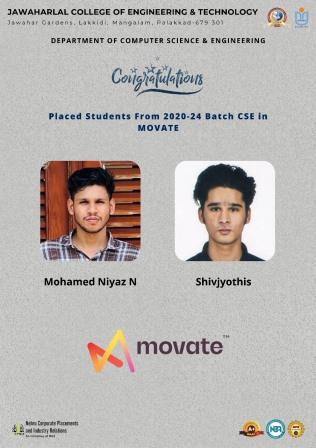
PLACED STUDENT 2020-2024 BATCH [ IN SPERIDIAN]
Congratulations to all the students who got placed in the reputed company

PLACED STUDENT 2020-2024 BATCH [ IN TECH MAHINDRA]
Congratulations to all the students who got placed in the reputed company

PLACED STUDENT 2020-2024 BATCH [ IN PROSPIRA]
Congratulations to all the students who got placed in reputed company
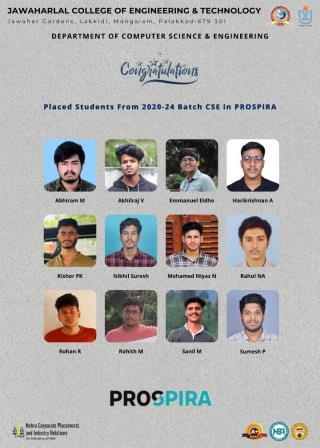
PLACED STUDENT 2020-2024 BATCH [ IN ASHOK LAYLAND]
Congratulations to all the students who got placed in reputed company

PLACED STUDENT 2020-2024 BATCH [ IN RAILTO]
Congratulations to all the students who got placed in reputed company

Other Links
- B.Tech. Aeronautical Engineering
- B.Tech. Civil Engineering
- B.Tech. Computer Science and Engineering
- B.Tech. Electronics and Communication Engineering
- B.Tech. Mechanical Engineering
- M.Tech. Applied Electronics And Communication Systems
- M.Tech. Communication Engineering and Signal Processing
- MBA
- Agriculture Engineering
- Computer Science & Engineering (Cyber Security)
- Computer Science & Engineering (Data Science)
Copyright © 2025 | All Rights Reserved.
